
Evidence on performance
Experience in Europe: Leeds, UK
Context
In 1998, UK’s first High Occupancy Vehicle (HOV) lane was introduced
on the A647 Stanningley Road and Stanningley By-Pass which form the principal
radial route to the west of Leeds city centre and are part of the route
linking Leeds and Bradford (see figures below). The scheme was experimental
at first but has become permanent. The road experienced severe congestion
and there were few public transport priority measures.
The £450 HOV lane scheme covers a total of 1.5km of 2.0km long dual
carriageway in two sections. They operate in the morning (07:00 –
10:00) and evening (16:00 – 19:00) peak periods on Mondays to Fridays.
Only buses, coaches, other vehicles carrying 2 or more people, motorcycles
and pedal cycles are allowed on these lanes (HGVs over 7.5T are not permitted).
Location of the A647 HOV Scheme in Leeds
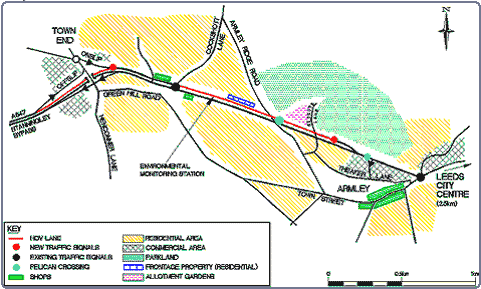
Scheme layout, High Occupancy Lane, Leeds. Courtesy of Leeds CC.
Illustrations of the Leeds HOV lane scheme.
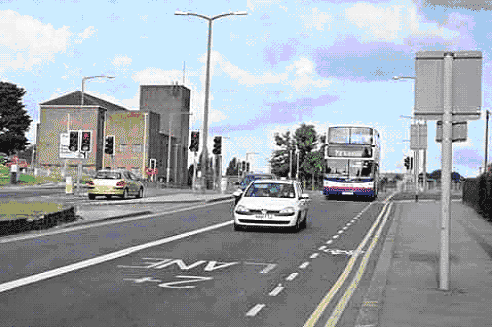
Courtesy of JMP Consultants Ltd
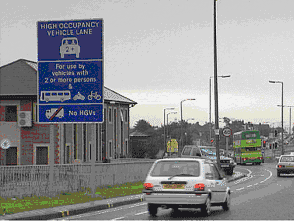
source ICARO (1999)
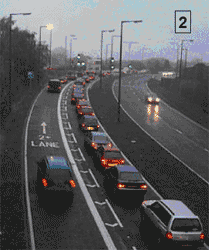
Courtesy of Leeds City Council
This project was part of an EU research project called ICARO (Increasing
CAR Occupancy). Its objectives were to increase car occupancy by encouraging
car sharing; and to demonstrate the feasibility of providing a lane for
shared use by buses, other high occupancy vehicles, motorcycles and cycles.
More detailed information can be found in the ICARO project deliveries
and final report (available at http://europa.eu.int/comm/transport/extra/final_reports/urban/icaro.pdf).
The following summary information is taken from the DfT’s ‘Bus
Priority: The Way Ahead’ initiative (case study on HOV Lanes) (DfT,
2004); Leeds City Council’s HOV Fact Sheet (2002); and ICARO (1999).
Impacts on demand
Prior to implementation of HOV lane, 30% of cars on the A647 (Stanningley
Road) had 2 or more occupants. With the inclusion of buses, one-third
of all vehicles carried two-thirds of all people (2225 of 3645) in the
morning peak period. The journey in free flow conditions could take about
3 minutes, regularly had taken over 10 minutes. Therefore a priority lane
such as an HOV lane would benefit a majority of the travellers in terms
of journey times. However single occupant drivers (total of 1420) would
be expected to suffer some additional delay due to capacity reduction
caused by the HOV lane.
The results below based on the ‘Before’ surveys that took
place in May and June 1997 and ‘After’ surveys that took place
in May and June 1999. Data collected included
• traffic counts in the morning and evening peak periods;
• vehicle occupancy;
• journey times;
• queue lengths; and
• personal injury accidents.
In addition to this, public attitudes and driver behaviour information
were analysed from household and roadside interview surveys. Air quality
was monitored by an environmental monitoring station on the route.
The following table summarises the results of before and after analysis
done by Leeds City Council (LCC, 2002). It was reported that, after an
initial reduction, traffic levels gradually increased to its previous
levels with about 5% increase in HOVs. This might indicate that there
was an exchange of HOV and non-HOV traffic between the A647 and parallel
routes. On the other hand, 26% of HOV interviewees were apparently new
car pools and cited the HOV lane as the reason for forming them. Relatively
low support amongst HOV drivers (about 66%) might have resulted from the
fact that these drivers also made peak period journeys as non-HOV drivers.
When doing so, they did not benefit from the journey time savings observed.
Leeds HOV lane impacts (Bus Priority Initiative case study, (LCC, 2002))
| Indicators |
Results |
| Morning peak traffic flows
(07:00 - 10:00) |
·
Immediately after
opening 20 % traffic reduction (due to driver avoidance).
·
By late 1999, traffic
flows returned to prior levels
·
Sight increase in
scheduled bus services, motorcyclists and cyclists |
| Evening peak traffic flows
(16:00 to 19:00) |
·
10 % reduction at
scheme inception
·
by June 1999, traffic
flows returned to the 'before' level
·
By June 2002 traffic
flow increased by a further 14 % |
| Occupancy and mode share: |
·
between 1997 and
1999, HOVs in morning period increased by 5 %
·
Average car occupancy
rose gradually from 1.35 in May 1997 to 1.43 by June 1999 and 1.51
in 2002
·
Bus patronage increased
by 1% in the first year of operation (There are indications of further
growth in bus patronage since 1998 but no real data available to
analyse) |
| Journey times: |
·
Morning peak journey
time savings for buses and other HOVs were 4 minutes (comparing
1997 to 1999 data)
·
Reduction of 1½
minutes in non-HOV journey times in the same period. |
| Queue Lengths |
·
By giving priority
to HOVs, two queues of equal length have been transformed into a
long queue in the non-HOV lane and a short queue in the HOV lane
·
No
evidence of non-HOV queues extending |
| Accidents: |
·
Reduction of 30
% in casualties in a period of three years after scheme implementation. |
| Enforcement: |
·
Lane violation levels
were low in the months following implementation
·
In 2002, lane violation
levels were still less than 6 % despite a relaxation of enforcement.
|
| Public attitudes: |
·
An increase from
55% to only 66 % in HOV drivers support for HOV lane (results from
roadside interviews in 1999). |
| Air quality: |
·
Little change in
air quality
·
A noticeable noise
reduction coinciding with both the morning and evening periods of
HOV lane operation |
The figure below shows the HOV lane journey time change along different
sections of A647 that resulted from HOV Lanes and signal improvements.
In 1998, morning peak HOV journey time savings were 3½ minutes
for a 5km trip from the Leeds Outer Ring Road to the Inner Ring Road.
In 1999, the time saving increased to just over 4 minutes. The figure
also indicates that the journey time savings starts after the first 2.5
-3 km and changes sharply from time lost to time gain.
A647 AM peak HOV lane journey times
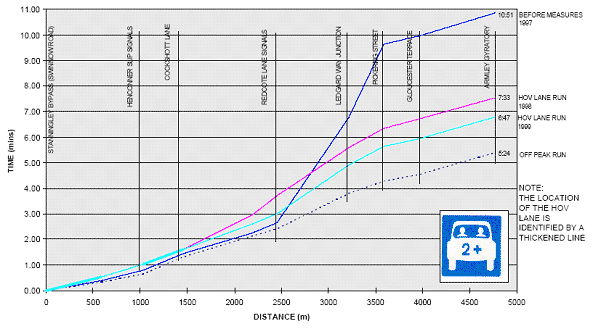
The figure below shows the journey time change on the general purpose
lanes (outside lanes) within same sections of A647. In 1999, overall inbound
non-HOV journey times did not increase and were total of 1½ minutes
shorter in the morning peak for the same 5 km long journey.
A647 AM peak non-HOV lane journey times
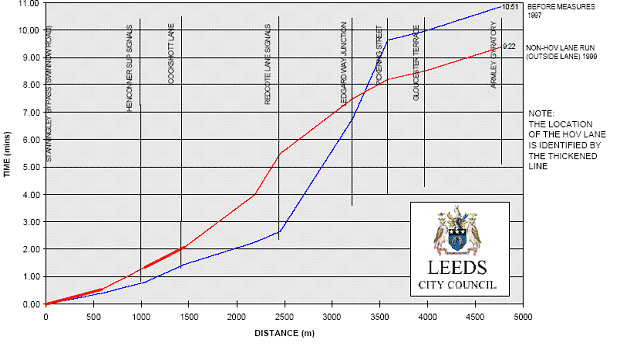
Costs
Scheme implementation cost was £585,000 at 1998 prices. Following
the success of the A647 scheme, Leeds City Council is now planning to
introduce HOV lanes on the proposed East Leeds Link Road.
Experience in Europe: Bristol, UK
On the congested dual two-lane Avon Ring Road near Bristol, the local
(South Gloucestershire) Council had wanted to implement a bus lane but
frequencies were too low to justify reallocating road space to buses alone.
It therefore opened an HOV lane for buses, taxis and cars with 2+ occupants.
The lane has been extended from the original 750m to 1.2km in length (comprising
two sections separated by a roundabout) and operates in one direction
in the morning peak only.
The lane has led to an increase in efficiency; the proportion of single
occupancy vehicles has fallen from 80% to 68%, and traffic levels have
increased by 10% (as a result of vehicles re-routeing from parallel roads)
as the lane has ‘smoothed’ flows and allowed higher throughput.
Journey times for all vehicles have fallen from 20 minutes to 6 in the
HOV lane and 12 in the mixed use lane.
Experience in Europe: Madrid
Context
One of the first and more significant European HOV lanes is the 16 km
two-lane scheme on the median of the N-VI motorway into Madrid which was
opened in January 1995. It was introduced when the motorway was widened
to accommodate traffic from nearly affluent suburbs. The lanes are reversed
to match peak flows and this has greatly increased throughput of traffic.
Impacts
A study of operational performance undertaken by the Madrid Polytechnic
University (http://ourworld.compuserve.com/homepages/ttr_oxford/london.htm)
demonstrated that:
In terms of efficiency, the N-VI HOV lanes were found to be positive
as they carry 59.3% of the morning peak hour travellers using 2 lanes,
while the 3 lanes of the main roadway carry only 40.7% of the travellers.
The proportion of 2+ vehicles increased from 30% in 1991 to 40% in 1996
The lanes have attracted a growth in public transport mode share, rather
than ridesharing.
The HOV lanes retain high levels of service through most of the peak
period because they still have some spare capacity. To fully utilise all
available road space, active policies to promote carpooling and public
transport use are needed.
Public transport use increased by 40% in the period 0700-1000 in the
year following implementation and more bus operators have begun operating,
so frequencies are higher. Monitoring reports also note a fall in congestion,
but there are no actual measures given.
Other results included:
• In inbound Madrid, the average occupancy in cars has increased
from 1.36 passengers per car in 1991 to 1.67 passengers in 1997.
• The modal split in the corridor has changed so that the use of
buses has increased from about 17 % in 1991 to about 26 % in 1997. In
the same period the use of cars has decreased from about 56 % to about
48 %.
• Reduced travel times in and out of Madrid has lead to the change
in modal shift.
Experience in Europe: Trondheim
The Trondheim scheme, which opened in May 2001, uses one lane in each
direction on a dual two-lane radial on the approach to the city centre.
The route was characterised by congestion during the morning and evening
peaks which affected the reliability of public transport operations, but
the delays were light – typically 5 minutes per vehicle lasting
for a period of about half an hour.
Different Trondheim schemes were tested with the American CORSIM model
and a 2+ scheme selected to balance usage and speed in the HOV lane and
congestion to general traffic.
Nordic Road and Transport Research (No 3, 2001) reports that the HOV
lanes offer journey time advantages of only 2-3 minutes in the peaks and
yet the proportion of 2+ vehicles has increased from 30 to 40% and there
has been a corresponding decline in single occupancy vehicles from 70
to 66%. This survey was limited to the HOV corridor and it was not clear
if carpoolers have been attracted from alternative routes.
Traffic levels in the area have remained stable, possibly because some
traffic has been attracted from surrounding residential streets, while
the number of people using the route has increased and person hours in
the morning peak have fallen by 20%.
In the mixed use traffic lane, the congested period has increased from
half to three-quarters of an hour; however, the city authority considers
this to be acceptable, especially has the scheme helped to regulate stop-start
conditions downstream.
Other European examples
As well as Leeds, Bristol, Madrid and Trondheim, there are converted bus
lanes in Linz (Austria) and rural Stockholm. There were also schemes in
Amsterdam and Berlin that were withdrawn because of legal opposition,
Shirley Highway and Santa Monica Freeway, USA
The first major US schemes were the Shirley Highway near Washington DC,
which opened in 1973 with two HOV lanes for cars with four or more occupants,
and the conversion of one lane of the Santa Monica freeway in Los Angeles
to HOV 3+ operation (including buses) during the peak hours.
The successful Shirley scheme now carries half of the commuters in the
corridor at an average speed of twice the mixed flow lane. However, the
Los Angeles scheme reverted to mixed use after just four months because
of poor planning and local opposition.
Adverse side effects
When it is not combined with complementary measures such as travel plans,
car sharing initiatives, public transport improvements, it might result
in under-utilisation in road capacity and therefore cause extra delays
to general purpose lane users.
In contrast, when time saving are high, it can induce trips from parallel
routes, induce additional trips or shifts from other times.
It may also cause abstraction of public transport users to join SOV drivers
to enable them to use the HOV lane.

|




